The difference between passive and active transport is mainly due to the two properties, like the movement of particles and the use of ATP.
The movement of particles: It occurs from a high to a low concentration in passive diffusion, whereas the particles move from a low to a high concentration in active transport.
Use of ATP: Passive transport does not require ATP, whereas active transport makes the use of it.
Passive and active transport is the biological process that helps in the transportation of nutrients, minerals, ions etc. across the cytoplasmic membrane. The cell or cytoplasmic membrane is selectively permeable for the type of molecules that are entering inside the layer. The transport mechanism merely called as the diffusion process, where the molecules or ions either move down or up (against) the concentration gradient.
In this context, we will discuss some of the major differences between passive and active transport along with the comparison chart. Besides, we can also learn the different types and mechanism of both the processes.
Content: Passive Vs Active Transport
Comparison Chart
| Properties | Passive transport | Active transport |
|---|---|---|
| Also known as | Downhill transport | Uphill transport |
| Movement | Molecules move from high to low concentration i.e. acts down the concentration gradient | Molecules moves from low to high concentration i.e. acts up or against the concentration gradient |
| Types of molecules transported | It can only transports simple, small and soluble molecules E.g. small monosaccharides, amino acids, soluble lipids etc. | It can transport all types of molecule E.g. protein, complex sugar etc. |
| Efficiency | Less | More |
| ATP expenditure | Do not require ATP input | Do require ATP input |
| Enzyme requirement | No | Yes |
| Types | It is of three types: • Diffusion • Facilitated diffusion • Osmosis | It is of two types: • Primary active transport • Secondary active transport |
| Requirement of carrier protein | No | Yes |
| Selectivity | Superficially selective | Highly selective |
| Effect of temperature | No effect | It effects the process of active transport |
| Effect of Oxygen-content | No effect | Reduces the efficiency of the process |
| Effect of metabolic inhibitors | No effect | Stops the process |
| Equilibrium inside the cell | Maintains the equilibrium | Disrupts the equilibrium |
| Examples | • O2 entering to the blood stream • Removal of glucose from the blood | • Uptake of Iodine by thyroid gland • Export of three Na+ ions and import of two K+ ion in Na+/ K+ pump |
Definition of Passive Transport
It is a biochemical transport mechanism, which can transport molecules from a high concentration to a low concentration without ATP expenditure through the semi-permeable membrane. Here, the particles will move down the concentration gradient, and the process is called passive diffusion.
Types
Passive diffusion generally has three different types:
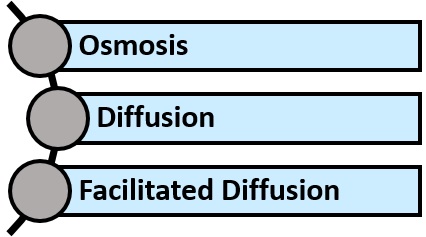
Osmosis: It allows the movement of a water molecule from a high concentration to the medium of low concentration through a semipermeable membrane. It depends upon the solute concentration. Example: Movement of water.
Diffusion: It allows the movement of small molecules like O2, CO2 etc. from the region of a high concentration to the medium of low concentration. Example: Movement of gases like oxygen, nitrogen etc., ethanol, short-chain fatty acids etc.
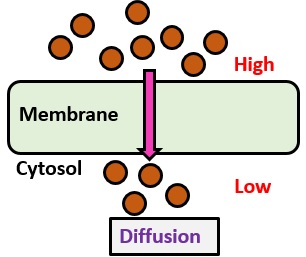
Facilitated diffusion: It is the movement of large molecules, charged ions etc. from a high concentration to the low concentration.
Examples: Movement of disaccharides like fructose, sucrose etc. The following two ways can mediate facilitated diffusion:
- Pump mediated: The movement of molecules is mediated through the channel proteins.
- Carrier-mediated: The movement of molecules is mediated through the membrane components.
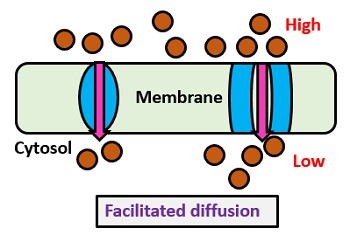
Definition of Active Transport
It is a biochemical transport process, in which the molecules are transported from a low concentration to the medium of high concentration by the use of ATP and some carrier proteins through the semi-permeable membrane. Here, the particles will move up the concentration gradient.
Types
Active transport generally possesses two different mechanisms, which we have discussed below:

Primary active transport: It is also called Direct transport. It makes the use of ATP directly to pump out the molecules or ions against the concentration gradient, i.e. from a low to high concentration medium. Therefore, it is a pump mediated transport. Uniport is a subtype of a primary active transport, which can transport one solute in one direction.
Example: Transport of amino acids, nucleotides, sugars etc.
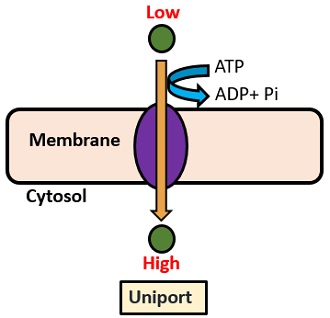
Secondary active transport: It is also called Indirect transport. Here, the molecules or ions move across the membrane by the protein present in the cell membrane by the help of energy stored in the concentration gradient after the break down of ATP. Therefore, it is Carrier-mediated transport, and it also involves the indirect use of ATP. One molecule acts against the gradient, and the other moves down the concentration gradient. It can be subdivided into the following two types:
- Antiport: It is the movement of different molecules in the opposite direction. Example: Sodium and Potassium transport.
- Symport: It is the movement of different molecules in the same direction. Example: Sodium and Iodine symport.
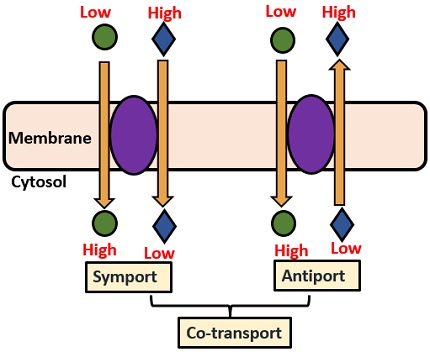
Cotransport: It is the combination of two systems, namely, symport and antiport. It is an obligatory system, which transports two solutes simultaneously either in the same direction or in the opposite direction.
Example: Transport of amino acid and glucose.
Process of Passive and Active Transport
The table showing the process of passive diffusion is given below:
| S.no. | Passive transport | Diagrammatic representation |
|---|---|---|
| 1 | Solute enters into the cell as a result of concentration difference | 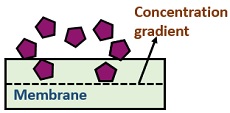 |
| 2 | It then leads to inward flow | 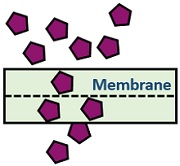 |
| 3 | When equilibrium is reached inside and outside the cell, the concentration gradient diminishes | 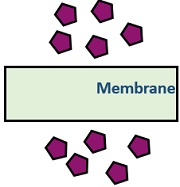 |
The table showing the process of active transport is given below:
| S.no. | Active transport | Diagrammatic representation |
|---|---|---|
| 1 | First solute particles bind to the receptor site of carrier protein | 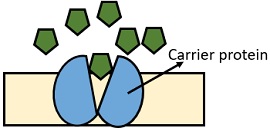 |
| 2 | It leads to the formation of solute-carrier complex | 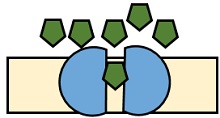 |
| 3 | Translocation of this complex across the membrane |  |
| 4 | ATP-mediated conformational change in carrier protein to release solute inside the cell |  |
Key Differences Between Passive and Active Transport
- In passive transport, the solute particle moves through the medium of a high concentration to the low concentration. Oppositely, the solute particle moves just opposite the direction of passive diffusion in active transport.
- Uphill and downhill transport is an alternative name for the active and passive transport.

- Passive diffusion does not require carrier binding, but active transport needs some carrier molecule to transfer the solute particles across the concentration gradient.
- Factors like temperature, oxygen concentration and metabolic inhibitors may either reduce the efficiency or stop the active transport of ions and molecules. Oppositely, the transportation of ions and molecules through passive diffusion remains unaffected by such factors.
- Active transport requires ATP input, whereas passive transport does not.
Conclusion
Thus, both passive and active diffusion plays a key role in the transportation process across the plasma membrane.